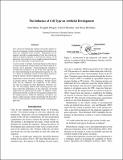| dc.contributor.author | Maher, John | |
| dc.contributor.author | Morgan, Fearghal | |
| dc.contributor.author | O'Riordan, Colm | |
| dc.contributor.author | McGinley, Brian | |
| dc.contributor.editor | P. Liò | |
| dc.contributor.editor | O. Miglino, G | |
| dc.contributor.editor | G. Nicosia | |
| dc.contributor.editor | S. Nolfi | |
| dc.contributor.editor | M. Pavone | |
| dc.date.accessioned | 2014-01-28T13:28:41Z | |
| dc.date.available | 2014-01-28T13:28:41Z | |
| dc.date.issued | 2013 | |
| dc.identifier.citation | John Maher; Fearghal Morgan; Colm O'Riordan; Brian McGinley (2013) The Influence of Cell Type on Artificial Development . In: P. Liò; O. Miglino, G; G. Nicosia; S. Nolfi; M. Pavone eds. Twelfth European Conference on the Synthesis and Simulation of Living Systems | en_US |
| dc.identifier.uri | http://hdl.handle.net/10379/4063 | |
| dc.description.abstract | Two variants of biologically inspired cell model, namely eukaryotic (containing a nucleus) and prokaryotic (without a nucleus) are compared in this research. Experiments are designed to provide an understanding of how the evolved regulation of protein transport to and from the nucleus of the eukaryotic type cell gives rise to complex temporal dynamics that are not achievable in a prokaryotic cell.A novel system of protein movement based on the process of nucleocytoplasmic transport observed in the biological eukaryotic cell is proposed. Nucleocytoplasmic transport is considered by biologists to be one of the most important factors when determining the developmental trajectory of a cell, as it allows for additional control of transcription factors entering the nucleus, thereby regulating gene activity. Experiments contrast the ability of both cell models to generate protein patterns within the cytoplasm. Results demonstrate that the additional cell complexity of the eukaryotic does not impede the Gene Regulatory Networks control. For increasingly difficult tasks requiring precise temporal control the performance of the eukaryotic cell model outperforms the prokaryotic cell model. In addition, results demonstrate that the second level of regulation introduced by the transport process within the eukaryotic cell allows very precise control of gene activity and provides the EA with a source of heterochronic control not possible in prokaryotictype cells. | en_US |
| dc.format | application/pdf | en_US |
| dc.language.iso | en | en_US |
| dc.relation.ispartof | Twelfth European Conference on the Synthesis and Simulation of Living Systems | en |
| dc.rights | Attribution-NonCommercial-NoDerivs 3.0 Ireland | |
| dc.rights.uri | https://creativecommons.org/licenses/by-nc-nd/3.0/ie/ | |
| dc.subject | Eukaryotic cells | en_US |
| dc.subject | Prokaryotic cells | en_US |
| dc.title | The Influence of Cell Type on Artificial Development | en_US |
| dc.type | Conference Paper | en_US |
| dc.date.updated | 2013-09-18T16:10:55Z | |
| dc.local.publishedsource | http://mitpress.mit.edu/books/advances-artificial-life-ecal-2013 | en_US |
| dc.description.peer-reviewed | peer-reviewed | |
| dc.contributor.funder | |~|Other|~| | |
| dc.internal.rssid | 5029140 | |
| dc.local.contact | Fearghal Morgan, Electrical & Electronic Eng, Room 3042, Engineering Building, Nui Galway. 3137 Email: fearghal.morgan@nuigalway.ie | |
| dc.local.copyrightchecked | Yes Embargo for 3 months from 3rd Sept 2013 | |
| dc.local.version | ACCEPTED | |
| nui.item.downloads | 373 | |


